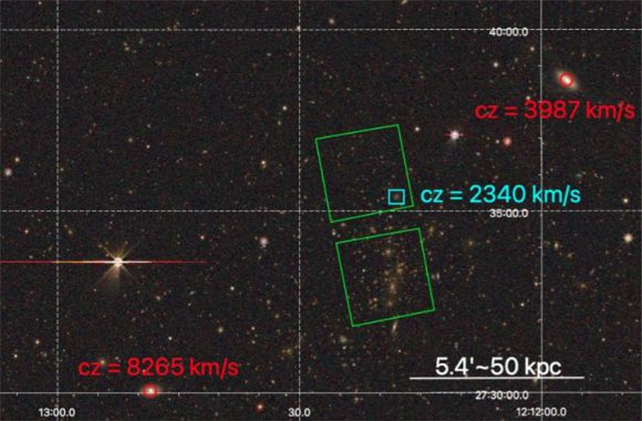Products You May Like
Astronomers working with the JWST found a dwarf galaxy they weren’t looking for. It’s about 98 million light years away, has no neighbors, and was in the background of an image of other galaxies. This isolated galaxy shows a lack of star-formation activity, which is very unusual for an isolated dwarf.
Most isolated dwarf galaxies form stars, according to a wealth of observations. What’s different about this one?
The JWST’s PEARLS (Prime Extragalactic Areas for Reionization and Lensing Science) observing program is aimed at understanding the epoch of galaxy assembly, active galactic nucleus (AGN) growth, and First Light. As part of its work, it observed a galaxy cluster called CLG1212. The isolated dwarf galaxy, named PEARLSDG, was found serendipitously.
The discovery is in new research published in The Astrophysical Journal Letters. Its title is “PEARLS: A Potentially Isolated Quiescent Dwarf Galaxy with a Tip of the Red Giant Branch Distance of 30 Mpc.” The lead author is Tim Carleton, an Assistant Research Scientist at the Arizona State University.
Dwarf galaxies contain far fewer stars than galaxies like our Milky Way. Nobody’s certain how many stars are in the Milky Way exactly. But well-reasoned estimates point to an upper number of about 400 billion. In contrast, dwarf galaxies like PEARLSDG contain up to about 100 million stars.
Besides its lack of star formation, PEARLSDG is unusual for another reason. The JWST is able to discern individual red giant branch (RGB) stars in the dwarf galaxy because the stars are bright in JWST’s observed wavelengths. It’s almost too far away for the JWST to see the stars, so PEARLSDG is one of the most distant galaxies in which we can see individual stars.

Being able to see individual red giant branch (RGB) stars makes studying the dwarf galaxy much easier. RGB stars have a specific intrinsic brightness, and that means that the astronomers behind the discovery can measure the galaxy’s distance: about 98 million light-years away.
They can also measure the stars’ ages, showing that the PEARLSDG stellar population is older. If it were still forming stars, some of the stars would be much younger.
The researchers write that the dwarf galaxy hasn’t formed a star in at least one billion years. Part of the evidence is in the lack of UV energy from the galaxy. Young stars emit powerful UV, yet PEARLSDG displays only low levels of UV radiation.
“Consistent with its low level of UV emission and the lack of emission lines in its spectrum, we find a very low sSFR, suggesting that its star formation shut off over 1 Gyr ago,” the researchers explain.
When a galaxy ceases to form stars, it’s called a quiescent galaxy. In a quiescent galaxy, the supply of gas used in star formation has been quenched. It’s usually caused by another neighboring galaxy that has interacted with the quiescent galaxy to halt star formation. Somehow, the interaction has stripped gas from the quiescent galaxy or disrupted the flow of gas.
But PEARLSDG has no close neighbors.

“These types of isolated quiescent dwarf galaxies haven’t really been seen before except for relatively few cases. They are not really expected to exist given our current understanding of galaxy evolution, so the fact that we see this object helps us improve our theories for galaxy formation,” said lead author Carleton.
“Generally, dwarf galaxies that are out there by themselves are continuing to form new stars.”
Interactions with other galaxies can cause quenching through tidal stripping. So can other environmental effects like ram pressure stripping and strangulation. But there are other causes, too, though astronomers are still working to understand them.
“However, recent observations of large numbers of ultra-diffuse galaxies have prompted the development of internal quenching mechanisms, such as strong feedback,” the researchers state. In strong feedback, powerful energy from the biggest and brightest stars can blow away gas needed for new stars to form.
Despite the fact that PEARLSDG has no close neighbors, the authors are cautious in their conclusions.
“Regardless, we cannot completely rule out past interactions with other galaxies that may have affected its formation history,” they write. “However, the recessional velocity and luminosity distance of PEARLSDG are consistent with it being in the Hubble Flow, and there are no visible signatures of tidal interactions.”
The Hubble Flow is what makes galaxies recede from one another as the Universe expands. Some galaxies interact and even merge despite the expansion because other forces have acted on them. But there’s no indication that anything has interacted with the dwarf galaxy that could’ve quenched its star formation.
When galaxies interact with one another, the tidal forces distort their shapes and can create tails and streams of stretched-out gas, dust, and stars. But PEARLSDG shows none of these symptoms. It’s a fairly non-descript, normal-shaped dwarf galaxy.
Discoveries like this make astronomers pause and reconsider their models of galaxy evolution. But it’s likely that the JWST will find more isolated and quiescent dwarf galaxies. As more are observed, things will become clearer, and eventually, there’ll be an explanation.
“More detailed analysis of the star formation history of PEARLSDG and the dynamics of PEARLSDG with respect to its surroundings are needed to further understand its formation history, but this discovery suggests the possibility that many isolated quiescent galaxies are waiting to be identified and that JWST has the tools to do so,” the researchers write.
But for now, it’s just one more mystery in the cosmos.
This article was originally published by Universe Today. Read the original article.
